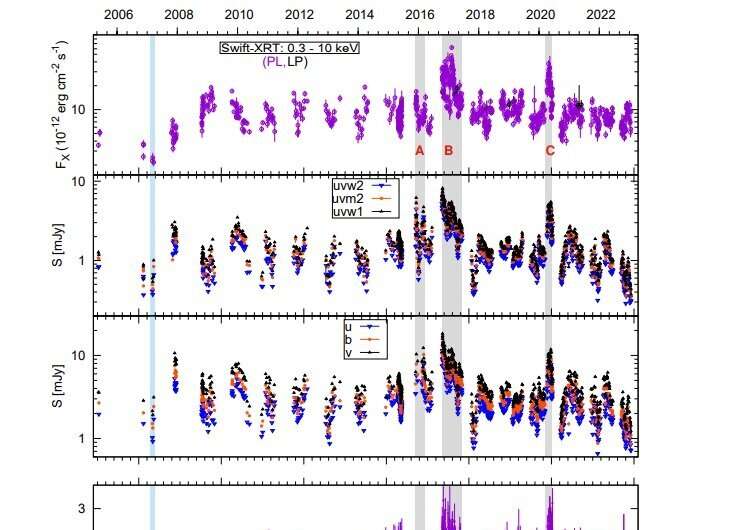June 5, 2023 report
This article has been reviewed according to Science X's editorial process and policies. Editors have highlighted the following attributes while ensuring the content's credibility:
fact-checked
preprint
trusted source
proofread
Research investigates spectral changes of blazar OJ 287

Using NASA's Neil Gherels Swift Observatory, Indian astronomers have observed a blazar known as OJ 287. Results of the observational campaign, published May 25 on the arXiv pre-print server, shed more light on the spectral changes of OJ 287, improving our knowledge about the behavior of this source.
Blazars are very compact quasars associated with supermassive black holes (SMBHs) at the centers of active, giant elliptical galaxies. They belong to a larger group of active galaxies that host active galactic nuclei (AGN), and are the most numerous extragalactic gamma-ray sources. Their characteristic features are relativistic jets pointed almost exactly toward the Earth.
Based on their optical emission properties, astronomers divide blazars into two classes: flat-spectrum radio quasars (FSRQs) that feature prominent and broad optical emission lines, and BL Lacertae objects (BL Lacs), which do not.
OJ 287 is an optically bright BL Lac located some 3.5 billion light years away from the Earth. Its supermassive black hole is estimated to be 100 million times more massive than the sun. The blazar exhibits a periodic variation of 11–12 years with a narrow double peak at maximum brightness, suggesting that it hosts a binary SMBH.
OJ 287 is one of the best-monitored blazars by the Swift spacecraft. Previous Swift observations of OJ 287 have found that it showcases peculiar spectral phases and that its spectra are representative of the entire blazar class. Recently, a team of astronomers led by Pankaj Kushwaha of the Indian Institute of Science Education and Research Mohali in India, decided to further investigate this topic, conducting another Swift study of OJ 287.
"In the current work, we focus on a detailed spectral investigation of the simultaneous optical to X-ray spectrum of the observed lowest measured X-ray flux state of OJ 287 by the Swift observatory," the researchers wrote.
The new observations found that OJ 287 has an extended optical-ultraviolet synchrotron spectrum, with a power-law photon spectral index of 2.71, which continues to X-ray energies during the lowest (and intermediate) X-ray flux state. Accounting for this in the spectral fitting, the astronomers inferred a hard intrinsic X-ray spectrum with a power-law photon spectral index at a level of 1.22, therefore harder than the hardest spectrum reported for this blazar considering only the X-ray data.
According to the study, the extended optical-ultraviolet spectrum of OJ 287 indicates a much extended high-energy particle spectrum. Moreover, the reported hard X-ray spectrum naturally reproduces most of the observed flat X-ray spectra of the source when combined with the corresponding optical-ultraviolet spectrum.
The authors of the paper noted that these findings could have implications for our general understanding of the flat X-ray spectra of OJ 287.
"The finding further strengthens our previous claim that most of the flat X-ray spectra of the source in the LBL/LSP [low-frequency peaked/low-synchrotron peaked] spectral phase of the source are due to the optical-UV synchrotron spectrum extending to X-ray energies," the scientists concluded.
More information: Pankaj Kushwaha, On the Spectral Changes of OJ 287—I: Particle Spectrum during the Lowest X-ray state—extended at Optical-UV and Hard at X-rays, arXiv (2023). DOI: 10.48550/arxiv.2305.16144
Journal information: arXiv
© 2023 Science X Network



















